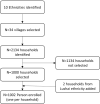Wide range of G6PD activities found among ethnic groups of the Chittagong Hill Tracts, Bangladesh
- PMID: 32925910
- PMCID: PMC7514097
- DOI: 10.1371/journal.pntd.0008697
Wide range of G6PD activities found among ethnic groups of the Chittagong Hill Tracts, Bangladesh
Abstract
The proportion of Plasmodium vivax malaria among all malarias is increasing worldwide. Treatment with 8-aminoquinolines remain the only radical cure. However, 8-aminoquinolines can cause severe hemolysis in glucose-6-phosphate dehydrogenase (G6PD) deficient patients. The population of the multi-ethnic Chittagong Hill Tracts (CHT) carry the highest malaria burden within Bangladesh. As in many countries the national treatment guidelines recommend 8-aminoquinoline based radical cure without routine G6PD deficiency (G6PDd) testing to guide treatment. Aim of this study was to determine the need for routine testing within a multi-ethnic population by assessing the prevalence of G6PDd among the local population. Participants from 11 ethnicities were randomly selected and malaria status was assessed by microscopy, rapid diagnostic test (RDT) and polymerase chain reaction (PCR). G6PD status was determined by spectrophotometry and G6PD genotyping. The adjusted male median (AMM) was defined as 100% G6PD activity, participants were categorized as G6PD deficient (<30% activity), G6PD intermediate (30% to 70% activity) or G6PD normal (>70% activity). Median G6PD activities between ethnicities were compared and the association between G6PD activity and malaria status was assessed. 1002 participants were enrolled and tested for malaria. G6PD activity was measured by spectrophotometry in 999 participants and host G6PD genotyping undertaken in 323 participants. Seven participants (0.7%) had peripheral parasitaemia detected by microscopy or RDT and 42 by PCR (4.2%). Among 106 participants (32.8%) with confirmed genotype, 99 (93.4%) had the Mahidol variant. The AMM was 7.03U/gHb with 90 (9.0%) G6PD deficient participants and 133 (13.3%) with intermediate G6PD activity. Median G6PD activity differed significantly between ethnicities (p<0.001), proportions of G6PD deficient individuals ranged from 2% to 26% but did not differ between participants with and without malaria. The high G6PDd prevalence and significant variation between ethnicities suggest routine G6PDd testing to guide 8-aminoquinoline based radical in the CHT and comparable settings.
Conflict of interest statement
The authors have declared that no competing interests exist.
Figures





Similar articles
-
Glucose-6-phosphate dehydrogenase activity in individuals with and without malaria: Analysis of clinical trial, cross-sectional and case-control data from Bangladesh.PLoS Med. 2021 Apr 23;18(4):e1003576. doi: 10.1371/journal.pmed.1003576. eCollection 2021 Apr. PLoS Med. 2021. PMID: 33891581 Free PMC article.
-
Prevalence of glucose-6-phosphate dehydrogenase deficiency (G6PDd), CareStart qualitative rapid diagnostic test performance, and genetic variants in two malaria-endemic areas in Sudan.PLoS Negl Trop Dis. 2021 Oct 26;15(10):e0009720. doi: 10.1371/journal.pntd.0009720. eCollection 2021 Oct. PLoS Negl Trop Dis. 2021. PMID: 34699526 Free PMC article.
-
Glucose-6-phosphate dehydrogenase deficiency prevalence and genetic variants in malaria endemic areas of Colombia.Malar J. 2016 May 26;15(1):291. doi: 10.1186/s12936-016-1343-1. Malar J. 2016. PMID: 27225440 Free PMC article.
-
Performance of the Access Bio/CareStart rapid diagnostic test for the detection of glucose-6-phosphate dehydrogenase deficiency: A systematic review and meta-analysis.PLoS Med. 2019 Dec 13;16(12):e1002992. doi: 10.1371/journal.pmed.1002992. eCollection 2019 Dec. PLoS Med. 2019. PMID: 31834890 Free PMC article.
-
Tafenoquine and G6PD: a primer for clinicians.J Travel Med. 2019 Jun 1;26(4):taz023. doi: 10.1093/jtm/taz023. J Travel Med. 2019. PMID: 30941413 Free PMC article. Review.
Cited by
-
Variation in Glucose-6-Phosphate Dehydrogenase activity following acute malaria.PLoS Negl Trop Dis. 2022 May 11;16(5):e0010406. doi: 10.1371/journal.pntd.0010406. eCollection 2022 May. PLoS Negl Trop Dis. 2022. PMID: 35544453 Free PMC article.
-
Glucose-6-phosphate dehydrogenase activity in individuals with and without malaria: Analysis of clinical trial, cross-sectional and case-control data from Bangladesh.PLoS Med. 2021 Apr 23;18(4):e1003576. doi: 10.1371/journal.pmed.1003576. eCollection 2021 Apr. PLoS Med. 2021. PMID: 33891581 Free PMC article.
-
Implementing radical cure diagnostics for malaria: user perspectives on G6PD testing in Bangladesh.Malar J. 2021 May 12;20(1):217. doi: 10.1186/s12936-021-03743-w. Malar J. 2021. PMID: 33980257 Free PMC article.
-
Heterogeneity in prevalence of subclinical Plasmodium falciparum and Plasmodium vivax infections but no parasite genomic clustering in the Chittagong Hill Tracts, Bangladesh.Malar J. 2022 Jul 14;21(1):218. doi: 10.1186/s12936-022-04236-0. Malar J. 2022. PMID: 35836171 Free PMC article.
-
Precarity at the Margins of Malaria Control in the Chittagong Hill Tracts in Bangladesh: A Mixed-Methods Study.Pathogens. 2020 Oct 14;9(10):840. doi: 10.3390/pathogens9100840. Pathogens. 2020. PMID: 33066621 Free PMC article.
References
-
- Ross A, Koepfli C, Schoepflin S, Timinao L, Siba P, Smith T, et al. The Incidence and Differential Seasonal Patterns of Plasmodium vivax Primary Infections and Relapses in a Cohort of Children in Papua New Guinea. PLoS neglected tropical diseases. 2016;10(5):e0004582 10.1371/journal.pntd.0004582 - DOI - PMC - PubMed
-
- Chu CS, Bancone G, Moore KA, Win HH, Thitipanawan N, Po C, et al. Haemolysis in G6PD Heterozygous Females Treated with Primaquine for Plasmodium vivax Malaria: A Nested Cohort in a Trial of Radical Curative Regimens. PLoS medicine. 2017;14(2):e1002224 10.1371/journal.pmed.1002224 - DOI - PMC - PubMed
Publication types
MeSH terms
Substances
Grants and funding
LinkOut - more resources
Full Text Sources
Medical
Research Materials
Miscellaneous

